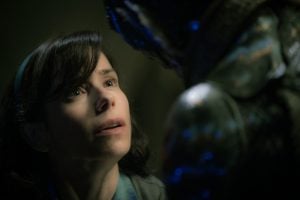The Shape of Water: Guillermo del Toro’s haunting, romantic & genre-defying imaginative fiction
March 9, 2018

The Shape of Water is Guillermo del Toro’s latest fantasy drama. A film which elegantly blends the mystical with the romantic, The Shape of Water tells the story of Eliza, a cleaner who works in a high security laboratory. One day whilst working, Eliza is exposed to a creature the lab are experimenting on. She grows fond of the creature and builds a relationship with him – a transgressive relationship which glides the film through the rest of its drama.
With a storyline where romance and fantasy seamlessly merge into an original cinematic experience, the film swims through a magical world – one which draws the audience to a place where Harry Potter and Stranger Things collide to create a unique sense of the fantastical. But this upside down has a mystical romance which enchants rather than intimidates. The humility and innocence of the relationship between human and creature takes the audience through the film’s narrative, creating a drama drenched in purity. Del Toro has arguably created a new genre. It is a subtle fantasy, whose nuance does not take away from the genre it sits under, but, instead, adds to it a whole other dimension: an escapism which manages to simultaneously confront real questions of human nature.
The film’s cinematic style is a style like no other. It fuses the dystopian and new with the old, classic and vintage. It is rich with nostalgic elements from the 1960’s that lend it a gorgeous authenticity, with traditional tastes of key lime pie, jello and American Diners. If you paused at any moment in the film and used it as a still, it would create a beautifully composed photograph. Del Toro’s attention to detail does not cease to live up to expectations following his iconic legacy. His placing a futuristic concept in a past time makes you wonder if the film is progressive or reflective. However, I would argue that this is what adds to the unique brilliance of the film: Del Toro is questioning and, perhaps, even exposing, the very notion of time before our very eyes.
There’s numerous references to iconic artists too due to the characters own artistic interests and passions. The camera cuts to images of Audrey Hepburn and Ms Monroe on the wall. It is a film conscious of it’s artists and own artistry. This makes the story of the two undiscovered and passionate artists all the more humbling. They are two individuals each struggling with their own issues, their own creations and passions, and the authority figures who get in their way.
Although the film is rich in classic authenticity, there is a danger which looms over the narrative tone. Aesthetically, Del Toro creates this fantastical world with a foil tone of blues and greens. A typically clinical colour which stands as a consuming and antagonistic atmosphere for these characters to live under, along with the motto which looms over them that: ‘Green- that’s the future now’. Whilst the colour tones saturates the film, the film is condensed in an obsession of time. The rhythm of the daily routine looms over this world; a world which is not like our own. These two aspects are the most haunting within the film, and stand against the romance which tries to push its way through the murky green waters.
There is drama in the film, naturally. However, the heavy drama is lifted on a float through the humility of its characters. Zelda, played by Octavia Spencer, takes on the motherly role to the innocent Eliza. Zelda acts as a guardian to Eliza, always watching out for her when her naivety can get her into trouble. We follow Eliza (Sally Hawkins) throughout this world. The use of the underwater world, and the illusion that comes with it, works as a clever metaphor. The loss of sense we get whilst under water is Eliza’s reality in the real world. Being a mute, she must be sense aware in other areas, all adding to her humble nature. Ultimately, therefore, behind the veil of fantasy is it a story about love, loneliness, and loss. Giles (Richard Jenkins), rejected for his homosexuality, is also one of these – as, of course, is the creature. The unlikely of alliances which can create not just an allegiance, but a beautifully enchanting romance. Beings on the verge of society and who are not understood come together: a clever timeless metaphor of the film.
The Shape of Water is concerned with beauty beneath the surface. People’s natures, characters; their souls. Our creativity, our imagination, our willingness to the fantastical is what will help us to survive in this world. As declared, most appropriately, in the words of late Ursula Le Guin: My imagination makes me human and makes me a fool; it gives me all the world and exiles me from it. What we don’t see is just as important as what we do.
See listings for The Shape of Water at HOME.
Filed under: Film, TV & Tech
Tagged with: fantasy, film, Guillermo de Toro, HOME, Home mcr, manchester, Octavia Spencer, Sally Hawkins, The Shape of Water



Comments